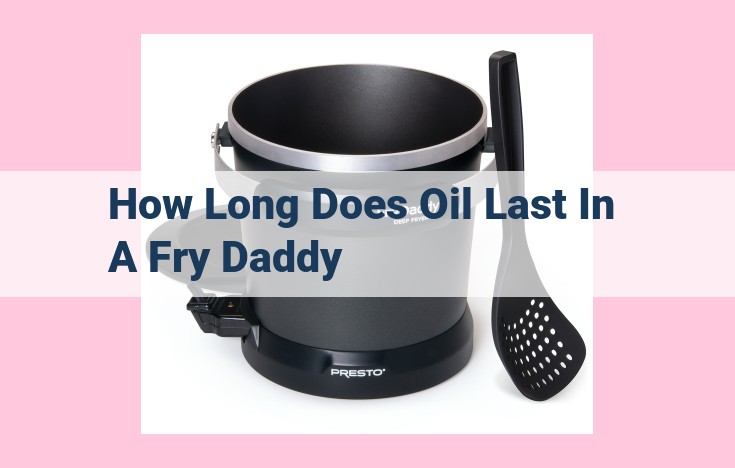Optimize Oil Longevity In Your Fry Daddy: Key Factors And Monitoring Techniques

Oil longevity in a Fry Daddy is influenced by factors like oil type (e.g., canola, vegetable), its free fatty acid content and smoke point. The Fry Daddy’s thermostat accuracy, oil filtration, and temperature control also affect oil life. Food factors such as water content, acidity, and protein content further impact oil degradation. Measuring oil longevity involves titration tests to assess free fatty acids, observing color changes for degradation signs, and monitoring foam formation as an indicator of deterioration.
Frying Oil: Your Secret to Crispy Delights!
Frying is an art form, and the key to a perfect fry is the longevity of your oil. Fresh, pristine oil not only yields crispier results but also preserves the flavor of your food.
Oil longevity can be affected by a multitude of factors, including the type of oil, the condition of your fryer, and the food you fry. Understand these elements and you’ll be able to maximize the lifespan of your oil, saving you time and money.
### Key Elements in Oil Preservation
- Choosing the Right Oil:
- Refined oils, such as canola or vegetable oil, contain fewer impurities and last longer than unrefined oils.
- Smoke point, the temperature at which oil starts to burn and smoke, is a critical indicator of longevity. Higher smoke point oils, like peanut or safflower oil, can withstand higher temperatures before breaking down.
- Maintaining Your Fryer:
- Accurate thermostats ensure even heating and prevent oil from overheating.
- Regular oil filtration removes food particles and impurities that can accelerate oil degradation.
- Proper temperature control prevents food from absorbing excess oil and keeps oil from reaching its smoke point.
- Watching What You Fry:
- Foods high in water content, such as vegetables, release moisture into the oil, which can break it down.
- Acidic foods, like vinegar-based sauces, can also shorten oil life.
- Protein-rich foods, like meat, produce tiny particles that contribute to oil deterioration.
### Monitoring Oil Longevity
- Titration Tests:
- These tests measure the free fatty acid content in oil, which indicates the level of breakdown.
- Color Changes:
- Darkening oil is a sign of degradation and should be discarded.
- Foam Formation:
- Excessive foaming indicates oil deterioration, potentially caused by impurities or the presence of water.
By understanding and controlling these key factors, you can extend the life of your frying oil, ensuring consistently crispy and flavorful food while also boosting the efficiency and economy of your cooking.
Oil Longevity for Frying: Key Factors to Consider
Maintaining optimal oil longevity is crucial for any frying enthusiast looking to achieve delectable and healthy fried foods. Understanding the various factors that influence oil longevity will empower you to extend its life and enhance your culinary adventures.
Oil Factors: The Heart of Frying
The type of oil you choose plays a pivotal role in determining its longevity. Refined oils, such as canola, soybean, or sunflower oil, boast higher smoke points and resistance to free fatty acid (FFA) formation, resulting in extended oil life. These oils have a lower concentration of impurities, leading to reduced FFA formation and oil breakdown.
Smoke point, the temperature at which oil starts to burn and release harmful compounds, is another important consideration. Oils with higher smoke points, such as avocado or refined coconut oil, can withstand higher temperatures, preventing premature degradation and extending their longevity.
Fry Daddy Factors: Guardians of Oil Longevity
Your Fry Daddy can significantly impact oil longevity. A precise thermostat ensures accurate temperature control, preventing oil from overheating and breaking down. Regular oil filtration removes food particles and other contaminants, reducing FFA formation and extending oil life.
Food Factors: The Unexpected Influence
The foods you fry also play a surprising role in oil longevity. Foods with high water content, such as vegetables, can cause spattering and foam formation, accelerating oil degradation. Acidic foods, like citrus fruits, can contribute to FFA formation. On the other hand, foods with high protein content, like meats, form a protective layer on the oil’s surface, slowing down FFA formation and extending its life.
Measuring and Testing Oil Longevity
Maintaining optimal oil longevity is crucial for ensuring the safety and flavor of fried foods. Here are key methods for measuring and testing oil degradation:
Titration Tests
Titration tests measure the amount of free fatty acids (FFAs) present in oil. As oil degrades, triglycerides break down into FFAs, which can negatively impact oil stability and taste. Titration involves adding a base solution to the oil and monitoring the change in pH to determine the FFA content.
Color Changes
Oil discoloration is another indicator of degradation. Over time, oil oxidizes and develops compounds that cause color changes. Darkening or cloudy oil is a sign of excessive FFA buildup and should be discarded.
Foam Formation
Foam formation is a telltale sign of oil deterioration. During frying, the interaction of hot oil with water and proteins from food can lead to foam generation. Excessive foam indicates the presence of emulsifiers and other compounds that have accumulated in the oil, compromising its stability.